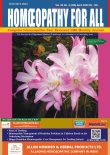The Power of Similars: Homoeopathy’s Dynamic Solution to Obsessive Compulsive Disorder
Keywords:
OCD, Obsessive Compulsive Disorder, Homoeopa thyAbstract
Obsessive-compulsive disorder (OCD) is a relatively rare neurosis marked by persistent obsessions and compulsions, impacting approximately 2.5% of the population. Its prevalence stands at about 2.5% among the general population and less than 5% among psychiatric patients. Onset typically occurs in adolescence, often before the age of 30, and affects both genders equally. Individuals with above-average intelligence are most commonly affected.
Downloads
References
Semple David. et al. Oxford Handbook Of Psychiatry. Third Edition. Oxford University Press.
Bhatia M S. Essential Of Psychiatry. Seventh Edition. New Delhi: CBS Publishers And Distributors; 2013.
Sadock Benjamin James. et al. Kaplan And Sadock's Synopsis Of Psychiatry. Tenth Edition. New Delhi: Wolters Kluwer (India) Pvt Ltd.
Ahuja Niraj. A Short Text Book of Psychiatry. Seventh Edition. Jaypee Brothers; 2011.
lcd-10 Classification Of Mental And Behavioural Disorders. India: Α.Ι.Τ.Β.S; 2007.
Hahnemann Samuel. Organon Of Medicine Word Index Combined. Fifth & Sixth Edition. New Delhi 110055: B Jain Publishers (P) Ltd.
Boericke W. Pocket Manual Of Homoeopathic Materia Medica And Repertory. Low Priced Edition. B Jain Publishers (P) Ltd.
Mondal Tapan Chandra. Spirit Of The Organon A Treatise On Organon Of Medicine. New Delhi 110055: B Jain Publishers (P) Ltd.




